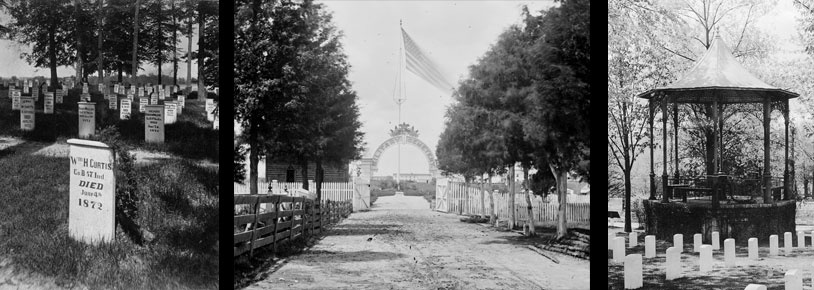

Civil War Era National Cemeteries: Honoring Those Who Served
San Antonio National Cemetery
San Antonio, Texas
 |
San Antonio National Cemetery Courtesy of the Department of Veterans Affairs, National Cemetery Administration, History Program |
In 1853, the city of San Antonio founded a new municipal cemetery, and sold sections of the new East Side Cemetery to church groups and fraternal organizations to establish their own burial grounds. In 1867, one such plot was donated to the Federal Government, creating San Antonio National Cemetery. Many of its first burials were the reinterments of Union soldiers from the cemeteries in and around the city, and as far away as Salado and Indianola.
The cemetery covers most of a rectangular city block, bound by Center Street to the north, South Monumental Street to the west, and Paso Hondo Street to the south. A portion of the city cemetery marks the eastern boundary of the national cemetery. A 1939 stone wall, four-feet tall and topped with cement coping, encloses the grounds on all sides. The design of the cemetery is distinctive, featuring two circular pathways, one each in the eastern and western halves, connected by a cross axis in the center of the cemetery. The cemetery’s main entrance, located along the southern edge of the site, is marked by a double wrought-iron gate, and is flanked on both sides by smaller pedestrian gates. The driveway from this gate leads to the eastern circle at the center of which is the cemetery’s flagpole. A second entrance is located on the cemetery’s northern boundary, directly opposite the main entrance, but is only accessible to pedestrians.
The cemetery features over 250 private monuments, the earliest of which dates to 1853. Section A, located around the flagpole in the eastern circle, is dedicated as the officers' section, while Section J, in the western circle, is set aside for soldiers who died at the military post of San Antonio. The only structure on site is the cemetery’s rostrum. Constructed in 1890, the octagonal rostrum is located just west of the main entrance. The base is constructed of stone block, and it is enclosed by a wrought-iron railing and accessed by decorative iron stairs. It originally featured eight tall columns that supported a metal tent-like roof. The roof and columns were removed in 1957.
The Unknown Dead Monument, located in Section H, honors all of the unknown soldiers buried at the cemetery, including over 300 buried in an adjacent common grave. A plaque nearby honors 35 soldiers of the Indian Wars who were buried as unknowns before being identified over a century later.
 |
Private Monument |
Brigadier General John L. Bullis, Union soldier and two-time Confederate prisoner of war, leader of the Black Seminole Scouts during the Indian Wars, and veteran of the Spanish-American War and Philippine Insurrection, is buried in Section A, Grave 174. Bullis is also the namesake of Camp Bullis, a major military training facility north of San Antonio. Lieutenant George E.M. Kelly, member of the U.S. Signal Corps, died when his Curtiss airplane crashed at San Antonio in 1911, the second serviceman to be killed in an aviation accident. Kelly is buried in Section A, Grave 117-A. Gustav Schleicher, a native of Germany who served in the Texas House and Senate, before being elected to Congress in 1875, is buried in Section A, Grave 140. Although he supported the Union prior to the Civil War, he became a Captain in the Confederate Army, leading General John B. Magruder’s corps of engineers. He is also the namesake of Schleicher County, Texas, approximately 200 miles northwest of San Antonio.
San Antonio National Cemetery is the final resting place for 13 recipients of the Medal of Honor, the nation’s highest military decoration, given for “conspicuous gallantry and intrepidity at the risk of his life above and beyond the call of duty.” Four recipients of the medal are buried as unknown soldiers, but are honored in the cemetery’s Memorial Section.
| Plan your visit |
San Antonio National Cemetery is located at 517 Paso Hondo St., in San Antonio, TX. The cemetery is open for visitation daily from sunrise to sunset. No cemetery staff is present onsite. The administrative office is located at the Fort Sam Houston National Cemetery, in San Antonio and the office is open Monday to Friday from 8:00am to 4:30pm; it is closed on all Federal holidays except for Memorial Day and Veterans Day. For more information, please contact the cemetery office at 210-820-3891, or see the Department of Veterans Affairs website. While visiting, please be mindful that our national cemeteries are hallowed ground. Be respectful to all of our nation’s fallen soldiers and their families. Additional cemetery policies may be posted on site. San Antonio National Cemetery was photographed to the standards established by the National Park Service’s Historic American Landscapes Survey. |